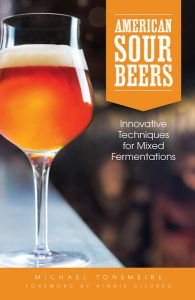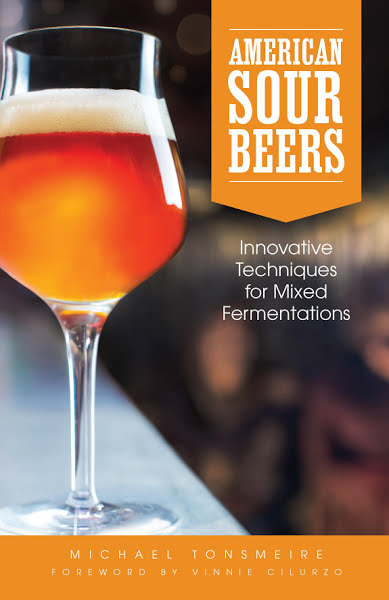Judging Category 28: American Wild Ales: An Interview with Michael Tonsmeire.
By Andrew Luberto, Assistant Communication Director

Michael Tonsmeire is the author of American Sour Beers (Brewer’s Publications, 2014) and writes The Mad Fermentationist blog. He is also co-founder of Sapwood Cellars Brewery in Columbia, Maryland.
Andrew Luberto: What do you see as some of the most prevalent misconceptions about “wild” fermented beer?
MT: Stronger flavors aren’t better than subtle ones. The style guidelines are loose, providing room for a judge to reward balance, drinkability, and nuance. Acidic or “funky” flavors that are unpleasant or overwhelming should deduct from the score. That said, you need to have an appreciation for your tolerance for acidity and the phenols that contribute aromatics from barnyard to plastic. Drinking a range of sour beers from a variety of breweries is the best way to understand the breadth of the “style.”
That’s what I look for in a sour, something that isn’t challenging to drink but something that isn’t bland or boring.
AL: Are there any particular strains of bacteria or yeast (or any microbes for that matter) that are relatively new that judges should be aware of if judging this category?
MT: Lactic-acid-producing yeast have become much more widely available and understood (in) the last couple years. For example, Wickerhamomyces,Lachanacea, Zygosaccharomyces, Schizosaccharomyces, and Hanseniaspora are capable of producing lactic acid and alcohol. The secondary metabolites they produce vary widely, but moderate to strong apple flavor is common. Many are bit players in lambic fermentation, but the available strains are often wild captured from tree bark.
AL: Any suggestions about approaching a beer in Category 28 “American Wild Ale” at a competition?

MT: Read the description of the beer and know what differences to expect from the range of microbes and techniques: kettle sour, 100% Brett, spontaneous fermentation etc. You’ll be required to parse these terms and more to understand the brewer’s intent. Learn to spot the most commo
n off-flavors: diacetyl (buttery), tetrahydropyridine (toasty to mousy), and ethyl acetate (solvent or nail polish remover).
With additional flavors from fruit or wood/barrels in 28C (Wild Specialty Beer) the rules are the same as any other specialty category: the addition should be complementary and can range from light to assertive. Know that some fruits are much easier to get an expressive character with than others, cherries and raspberries will provide a more distinct aroma than plums or kiwi.
There has to be some judgement on did they live up to the description that they set for themselves, but there also has to be some judgement on was this a good idea.
Other key takeaways from our conversation:
- American Wild Ales is a bit of a unique beer category in that most of the time, the brewer needs to have at least some rudimentary knowledge of common wild ale microbes to describe what exactly it was that they made.
- Accurately assessing what the brewer intended can be challenging for beer judges in this category. Some yeast labs don’t even specifying what strain of microbes are present in some of their products. It’s not uncommon for someone judging this category to see something in the description like “used Omega C2C American Farmhouse” for which the company only specifies “Bretts and Blends” under strain type. In addition, even just specifying something like “Brettanomyces Bruxellensis” doesn’t account for the wide range of character different species of B. Bruxellensis exhibit as well as secondary characteristics from any number of mitigating circumstances arising from interactions with other ingredients and the brewing process.
As Tonsmeire pointed out in our conversation, the differences between different types of Brettanomyces Bruxellensis is “just like the Saccharomyces cerevisiae species represents ale yeast as diverse as those strains used by Sierra Nevada and Westmalle, so too are there a huge range of B. bruxellensis isolates. Everything marketed as B. lambicus falls under that umbrella as well as it is an outdated nomenclature still used for marketing. They can have a range of characteristics from fruity to funky, so just knowing the species gives you a little information, but honestly not much to make a judgement about what flavors to expect.”
- Judges also need to be aware of the sensitivities and check their preferences. Although many associate the character of the hay/barnyard quality of 4-Ethyl Phenol with the use of Brettanomyces there is nothing inherently better about this characteristic than say the flavors of other brett strain characteristics like pineapple or cherry or even 100% brett fermentation which may or may not have “funky” character to it. “There is no preferred Brett characters” as Tonsmiere points out, “you shouldn’t require or penalize for not having any of those (commonly associated brett characteristics)”.
In addition, given the wide range of flavors and combinations this category comprises, it’s important for judges to understand what their flavor sensitivities are. Being aware that the way we perceive and process flavor can vary greatly from person to person and knowing what elements you’re more prone to pick up or miss at lower or higher thresholds are key. Consult with your fellow judges, that’s what they’re there for and use the knowledge about your palate to help in the evaluation process. Michael says, “ There’s certainly those who are hypersensitive to diacetyl or phenols. Plasticy and band aid are things that some people have a very very low tolerance for. A good friend of mine, who’s a great brewer, for almost every Brett beer (he tries) he just goes “plastic”… so understanding your palate and understanding if you really love acid and something is a tiny bit too acidic for you, that may tell you that’s it way too acidic. Or if its not acidic enough you might have to understand that not everyone wants a beer with a Ph down in the low 3s.”
Final thoughts:
“it’s hard for the average judge who isn’t a sour nut to have that kind of level of understanding so I think you really have to come down at least a little bit to, are these flavors harmonious, are these flavors complimentary, are these flavors interesting. Do I find myself going back for another sip” Michael concludes.
In the end it’s really just about do flavors work or not, which is really what judging boils down to anyway.


